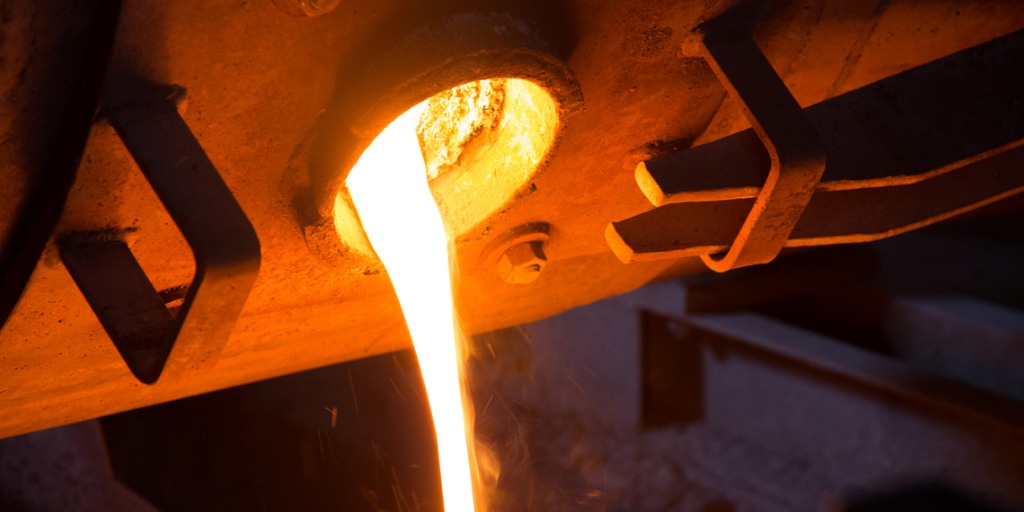Glass 101: Glass Processing Temperatures
Posted on Aug 14, 2019

Glass is an amorphous solid with no long-range order. This lack of order is what differentiates a glass from a crystalline solid. For example, when silicon dioxide is cooled slowly through the crystallization temperature, it is allowed to form crystals, giving the solid a geometric structure throughout the material. When silicon dioxide is heated and then rapidly cooled, it’s ordered crystalline structure is unable to reform and it becomes an amorphous solid (glass). [1]

Glass goes through different transitions during melting. The glass transition temperature, softening point, and crystallization temperature are all part of the glass forming process. Careful maneuvering through these steps is critical to the formation of a stress-free glass product.
Glass Transition Temperature
The glass transition temperature (Tg) characterizes a range of temperatures where an amorphous material transitions from a hard brittle state to a viscous state relative to increasing temperature.[2] The solid begins to exhibit viscoelastic properties above Tg. When disordered molecules are below Tg, they have less energy, and the molecules aren’t able to move into new positions when stress is applied. When above Tg, the molecules have more kinetic energy, allowing them to move in order to alleviate applied stresses.[3] The annealing temperature is selected based on the glass transition temperature, allowing any stress to be released before completely cooling the glass.
Littleton Softening Point
The Littleton softening point (Ts) of glass is the temperature at which the glass moves under its own weight. As a glass is heated, the glass flows more easily. The resistance to flow is known as viscosity. At the softening point, the glass has a viscosity of 107.6 poise.[4] This point is often used to define the working range of the glass. Once the glass has reached the softening point, it is malleable without melting.
Crystallization Temperature
The crystallization temperature (Tx) characterizes the onset of crystallization. Crystallization is the process of forming a solid. The molecules become highly organized into a geometric structure known as a crystal. This occurs in two steps. The first step is the nucleation or “seed” formation. Nucleation can be influenced by the initiation of a secondary phase formation within the matrix or the introduction of an outside substance, such as particles from the crucible. The second step is crystal growth, which is the growth around the original nucleation sites in layers.[5] Crystallizing brings the melt down to a lower energy state. If a melt crystallizes it will not become a glass since glass is a disordered solid. Crystallization is avoided by rapidly quenching through the glass transition region.
Coefficient of Thermal Expansion
The coefficient of thermal expansion (CTE) describes a material’s change in shape, area, and volume in response to temperature change.[6] Heat is a type of kinetic energy. When a material is heated, its kinetic energy increases which causes the molecules to vibrate at a higher frequency. The molecules then take up more space than usual. The reverse is true when cooling a material. When cooled, the molecules have less kinetic energy, and they contract, taking up less space....
Mo-Sci Corporation’s extensive glass knowledge and research experience make it a perfect candidate for custom development needs. Mo-Sci has partnered with companies across a wide variety of industries, creating custom glass solutions for unique applications. Contact us for more information on how we can help with your next glass product.[8]
References
- NDT Resource Center, http://www.ndt-ed.org/EducationResources/CommunityCollege/Materials/Structure/solidstate.htm, Center for NDE, Iowa State University.
- ISO 11357-2: Plastics – Differential scanning calorimetry – Part 2: Determination of glass transition temperature (1999).
- The Glass Transition. https://pslc.ws/macrog/tg.htm. Accessed: 21 June 2019.
- Technical Glasses: Physical and Technical Properties | SCHOTT Technical Brochure. https://www.us.schott.com/d/tubing/ffed51fb-ea4f-47d3-972e-5a2c20f123f5/1.0/schott-brochure-technical-glasses_us.pdf. Accessed: 21 June 2019.
- Crystallization |Reciprocal Net http://www.reciprocalnet.org/edumodules/crystallization/. Accessed: 24 June 2019.
- Tipler, Paul A.; Mosca, Gene (2008). Physics for Scientists and Engineers – Volume 1 Mechanics/Oscillations and Waves/Thermodynamics. New York, NY: Worth Publishers. pp. 666–670. ISBN 978-1-4292-0132-2.
- Novel Sealants to Significantly Improve the Lifetime and Performance of Solid Oxide Fuel Cells | Mo-Sci Blog https://mo-sci.com/novel-sealants-Improve-solid-oxide-fuel-cells. Accessed: 25 June 2019
- Mo-Sci Corporation Website https://mo-sci.com/en/custom-development. Accessed: 24 June 2019.
No comments:
Post a Comment